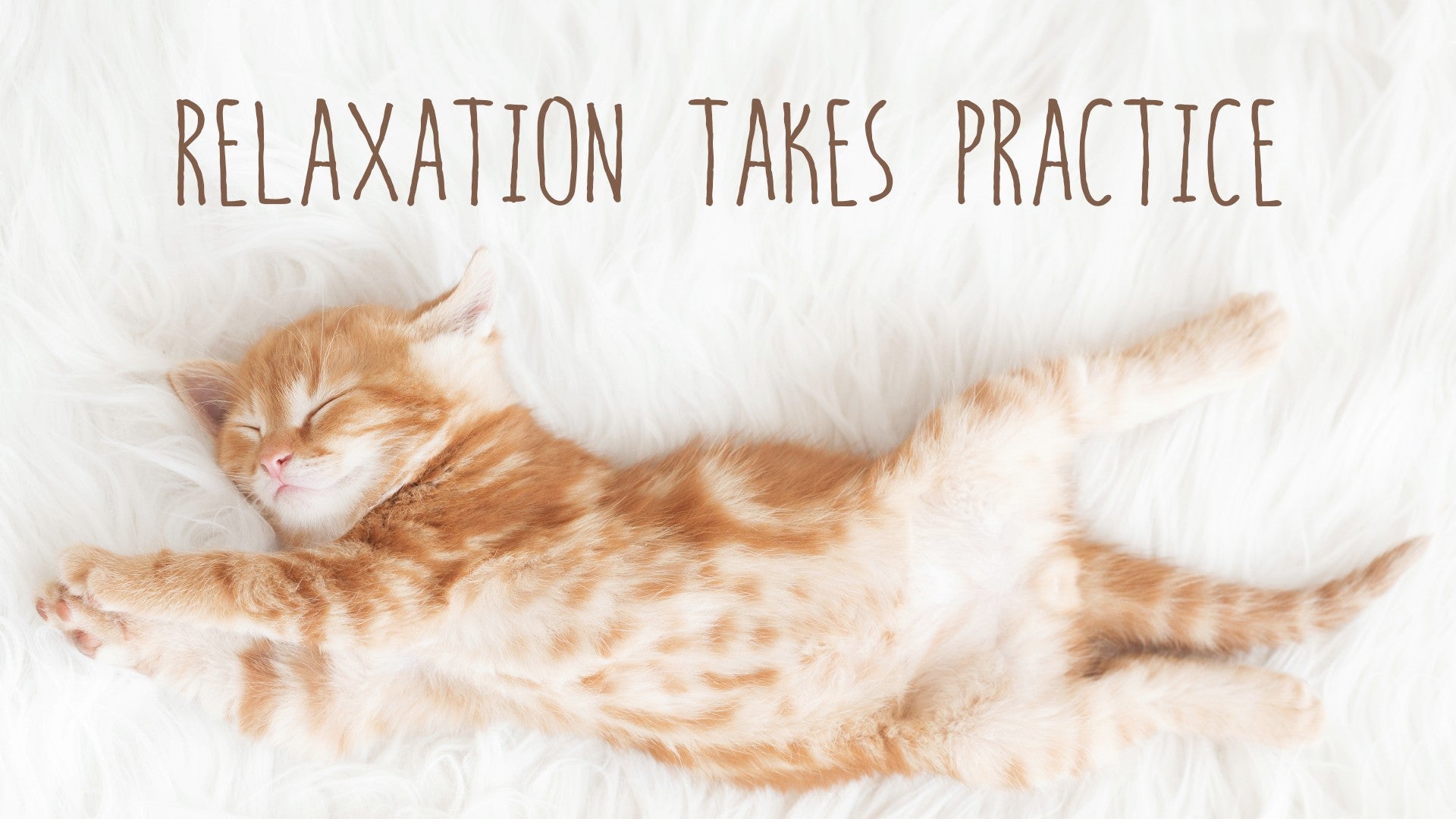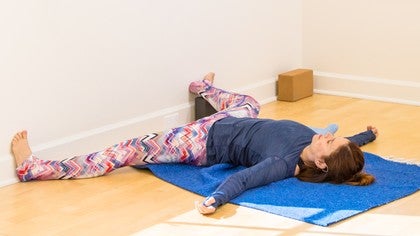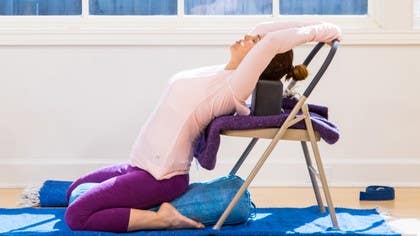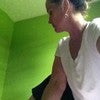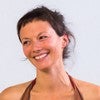Description
About This Video
Transcript
Read Full Transcript
(waves crashing) Namaste. Thank you for joining me today. We're going to move through a standing restorative yoga session, and the only thing that you really need is two blankets, and a wall, and a bolster. And what I've done right now is I've just set out this blanket already on the floor. If you have a sliding surface, you'll want a blanket.
If you don't, you're on a carpet, you won't need a blanket. So, let's get started. The first one is Triangle Pose on the floor. So, you might want to watch me since you haven't, if you haven't done this before. If you feel a little like, "I don't know what she's doing", then just take your time, watch it, you can come back to it another time.
Okay, so let's get started. I'm going to take my body and put it in a 90 degree angle with my feet at the wall. These two blocks that I have, and by the way, I have a cork block on the bottom and a foam block on the top, but it doesn't matter, they can be any kind of blocks that you prefer. I just like a little bit of cushion underneath my top ankle. I'm going to take myself in at 90 degree, come really close to the blocks so that my feet can be on top of them, and then I'm gonna slowly roll down on the right side of that body.
I'm gonna take my top leg, that's my left leg, and kick it back just a little bit so that the toes are curled under, and right at the base of the floor. Then, I'm gonna take my top leg, that's my right leg, and set it on top of the block. And then slowly I just push away, push away, push away, until I can stretch my left leg all the way out to the side. Then, I bring my right arm down, slowly lower my spine and my head, and stretch my left arm all the way out. I'm gonna slowly begin to take that left foot right up against the wall, slide a little closer to the blocks, and then stretch my arms all the way out to the sides.
So, think about how you are if you've practiced Triangle Pose in the middle of the room. Your head can either be in a neutral position, or it can turn all the way over the outstretched arm. So, just do what feels good for your neck. You're gonna stay a little firm in your legs, but the idea here is to slowly release the weight of your pelvis into the ground so there's less and less resistance. So, we're gonna be here for about two minutes.
And bit by bit, as things begin to open up, you may sort of adjust your feet. Maybe you get a little bit more reach of the back leg. Maybe you decide to turn your chest open a little bit more by rotating your ribs, and your belly, and your chest to the left. And maybe you decide that the stretch that you have now in the front leg, doesn't quite need the same amount of support that you started with. If that's the case, you can take your right hand, bring it underneath the knee, and bend the knee, and just kick that other block out of the way, and then rest that foot on the bottom block instead.
Release your arm again, see how that feels. (exhales) The goal is not to have the greatest sensation possible. These are not sensation seeking poses. Restoratively what we're trying to do is release into the shape of the pose with the least amount of tension, and the most amount of interest. Go ahead and notice the breath that you're taking right now and complete one more inhale and exhale.
When you finish that last one, bend the back leg, that's the left leg, bend it and just set that foot flat on the floor. Pause for a moment. Bend the left elbow. Bring that arm in towards your chest. Pause.
And then use your left foot to slowly push off the back leg, bend the front leg. Take that right leg and stack it underneath the top leg. Roll all the way to the right in sort of a sloppy fetal position, and just wait. Then we'll prepare ourselves for the opposite side, so roll yourself to your back again. Settle yourself in the middle of your support.
So, we're gonna roll to the right side and prepare for the other side by moving our support. So, I'm gonna take the blocks and just bring them right over to the left side. Stack them as I did before. Cork's on the bottom, and then the foam is on the top. And just like before, we're coming on the left side of the body, pretty close to the blocks, and then this 90 degree with the feet stacked, the knees stacked, the hips stacked.
I pull my spine back just a little bit and release the head. And I'm gonna take the top leg and stretch it back, and it's just softly stretched, you don't have to go for the biggest reach, yet. And then take that bottom leg, that's the left leg, bring it on top, and then slowly I push. And sliding your blanket's gonna bunch up a little bit, it's okay, you can kind of move it around a little bit until it gets into the right position for you. And then I'm gonna move that right leg as far back as I comfortably can, and then slowly begin to roll open.
And then there's a little bit of adjusting that has to happen. So, I scoot my hips to the left. I firm my back leg a little. And then I feel like I can go a little deeper, so I'm just gonna slide myself a little more and try to smooth my blanket out a little bit. The blanket's important if you have it on the floor because it's supporting you, so you don't want a whole lot of wrinkles underneath you.
And then I've got that top leg on the block, and I'm gonna reach my bottom arm, that's my left arm, down, and then slide my other arm up over head. And again, just imagine you're in the middle of the room if you've done this pose before. And maybe I try to turn my chest up just a little bit, and now we'll be here for about another two minutes. I take my breath in. I let the weight of my body settle into the shape.
Each time you come to this practice, especially when you're doing one side or the other side of the body, it may be a little different, so I just make an adjustment for that. I feel a little more open on this side, so I am going to go ahead and bend that top leg and kick that block off. Just bring it to the side, set my outer foot on that support, and I'm gonna actually move a little closer, 'cause it makes sense for what's happening right now. And now it's just about letting the weight of the body release into the shape. Deliberately letting go on those exhalations.
Noticing the areas I may hold. Listen to your breath. Notice the breath that you're taking right now. And go ahead and take one more breath. And the first thing you're gonna do to release out of the pose, is bend the back leg, that's the right leg, so go ahead and bend it.
Just set that foot flat on the floor. And then go ahead and bend the right elbow, and bring that arm in toward the chest. And then you're going to push off the back leg, that's the right leg, bend the bottom leg, and slowly roll yourself to the left in that sloppy fetal position. And pause. And then we're gonna return to the center again, so I'm just gonna roll over on my backside, get back in the middle, set my feet flat, and return to my center.
So, we're gonna go ahead and move into the next pose which is Virabhadrasana II, or Warrior II Pose. So, I'm gonna just shift my hips over to the right and roll over to my left side again, so I can put my props in the right position. And for this one I'm just going to use one block, but if you feel as though your inner thighs feel a little tight, you'll wanna use both of the blocks. But, for right now, because of the cushion, I like to use the foam blocks, so I'm gonna have the foam block here, and I'm gonna put the block to the side for right now 'till I use it again for another pose. And I'm also gonna grab this blanket.
So, you're going to have your blanket, I call this a meditation pad, and basically it's just a blanket folded in fourths, and then one more time. You wanna use this for the front leg. So, because we're moving our right leg in the 90 degree and our left leg in the straight position, I'm gonna have the blanket to the right, and I'm also gonna have the block to the right. I'm gonna have it on its highest end, so it's the long, thin edge. Put it right up against the baseboard.
I'm coming down to my backside again. I'm gonna smooth the blanket out a little. And then just like before, we're rolling over onto the right side. This is that metric for setting up all these standing poses. I get pretty close to the block.
I have my other blanket nearby. Now, I'm going to pull the top leg, that's the left leg, away from me, take my bottom leg, my right foot, put it right on top of the block, and then I'm gonna scoot my spine to the right so that when I look up, I can see that my spine is in a straight line, it's not tilted to one side or the other. Here's sort of the tricky part. You're gonna slowly begin to walk that left leg all the way out to the left. And then I'm placing this blanket right underneath the top of my thigh.
That's the heaviest part of my leg, so I want the weight to release down. When I look up I sort of just want to see am I surfing to the side or not, and if I am, I'm gonna scootch myself away from the wall a little bit. Kind of forgive my flexibility. And then once I see that my spine is directly over my pelvis, I just open my arms out to the sides. We're gonna be here for a bout two minutes.
One of the things that you wanna feel for is that both of the buttocks are fairly weighted equally onto the floor. If you feel as though your back hip, your left hip, is not at all, I suggest you walk your right foot higher up the wall and adjust the block to meet it. And this way you're not overstretching one side. (exhales) Once again, I make little adjustments as I find myself wanting to be a little more comfortable in the shape. And then it's just the breath.
If you need to come out of the pose before you hear the instruction, always feel free to do that. Listen to the breath that you're on right now and go ahead and complete one more inhale and exhale. And then when you finish that, you're gonna release the back leg, that's where most of the stretch, you might feel most of the stretch there or a little more, and just draw that leg in. You can pull it right in toward your chest. It'll feel good.
And then bend the left elbow, bring it in toward your chest. Once again we're gonna roll to the side, so I'm just rolling to my right side, resting in that sloppy fetal position, letting my head come down and pausing. (breathes deeply) And then we're going to prepare for the next side. Rolling over to the center. Pausing.
So, let's move over to the right side and set the props up. It's so easy, right? You already know what you're doing.(laughs) So, I'm gonna just make my blanket a little straighter. Just a little squish. Okay, so take your block and bring it over to the left side, bring your blanket with you.
And roll over onto the left side like you did before. Stacking everything up. Coming pretty close to the block. And then slowly go ahead and release your head down. Take your time, there's no hurry for any of this.
And I'm gonna take the top leg and stretch it back. And then take the bottom leg, put it on top of that block. And then I'm gonna reach my right leg as far back as I can and then scoot my pelvis to the center. And I think it's important to look up and make sure that the alignment is, ooh, this side is a little tighter (laughs). So, I'm going to pull back away from the wall a little bit because I know that when I go to put my spine, when I align it, align it over my pelvis, that that right hip's gonna want to pop up.
So, once I look to see that that's there, then I can begin to relax and do it. Stretching my arms out and placing that blanket underneath my top thigh. And just take one more little glance to make sure it's all copacetic. My palms turn up and then I can begin to settle into the shape. So, now we're gonna be here for those two minutes.
Take a breath and relax into the shape of the pose and into the weight of the pose. These standing poses are so interesting because they really show us where we are in the middle of the mat, but we may not realize where we are. That's because we have a solid ground beneath us. In that way, they're a little unforgiving, but it's okay, this is the beauty of the restorative poses. We have time to sink into it.
And the little nuances like I move my head from side to side a little bit, that allows me to let my shoulders release. And then I can just breathe and feel my way into what's happening. And because I can feel the pose opening up a little, I am gonna now come a little closer to the wall. So, I'm just bending my back leg. This is an option for you if you experience the same thing and I just slide my pelvis a little closer to the wall.
And then stretch that back leg out again. And now I feel like I'm back in relationship with the pose. So, go ahead and take one more breath, listen to it, and then we prepare to come out of it. So, we're gonna bend the back leg, that's the right leg. Just set that foot flat.
Take the right arm, bend the elbow, bring it in toward your chest and then roll all the way over onto the left side. And just stack those legs again and rest in that little fetal position. And all is well. (laughs) We're gonna roll over into the middle. Back down on the spine, feet come flat, I shift my pelvis so it's in the center. Make sure my shoulders are down away from the ears.
And settle back into my center. Okay, so we're going to move into the third pose, the Parivrtta Trikonasana or Revolve Triangle Pose on the floor, supine style. So, let's roll over to the left side and then go ahead and push up. We just need the two blocks for this variation, so I'm gonna move the blanket that we used and bring it over to this side since I don't need it. And I'm gonna grab the other block, and just because I like to keep everything nice and clean, smooth my blanket out again.
Now, I'm going to stack the blocks like we did in the Triangle Pose. So, the cork block's gonna be on the bottom and the foam block is gonna be on the top. And this is for sort of general flexibility, if you feel like, "Oh, I can take a little bit more than that", then just get rid of one of them, and you can always kick it out like we did earlier in the other pose. But, this is how I'm gonna start it off. So, I'm gonna take these two blocks and stack them here.
Come down on my right side once again. Same setup as before. The key here is to get very close to the wall with your thighs. You want them to be parallel to the wall. And if you don't, when you kick your legs apart from one another, you'll push yourself so much away from the wall, that you won't be close to the pose.
So, the idea is to keep maintaining and doing things that keep you in relationship to the shape of the pose. In this case it's a twist. So, I'm gonna come down on that right side. Get myself so that I'm pretty parallel. Let me come a little closer to the wall.
Stack myself up. Then, I'm gonna take my top leg, that's my left leg, and stack it. These blocks should be right up against the wall. Stack it right on top of the block and then you might want to watch, as I suggested earlier, you're gonna take the bottom leg, that's the right leg, and kick it behind you. And don't straighten the leg all the way out, just kick it behind you so you can feel your toes come to the wall, 'cause you're gonna use that to push and rotate at the same time.
So, my left arm, my top arm, it just rests right along side my chest. And I'm gonna push the right foot into the wall and slide my torso to the right. Just a little bit. Maybe four or five inches. Then, I'm gonna stretch my right leg all the way out, like in a runner's position, I'm pressing that ball, the foot, to the wall.
Then, I drop my head and walk my right hand toward the wall, and here comes the juicy part, I slowly begin to rotate my chest to the left, dropping my left arm onto the floor. Okay, now this back leg, the right leg, it doesn't have to be totally straight. There's not a lot of rules in this. The rules that do exist are both shoulders on the floor and the block underneath the foot, whether it's two blocks, one block. Maybe you don't want a block, that's okay, too.
So, I'm gonna deepen myself a little more by sliding my torso to the right, straightening my back leg, and unwinding into this great twist. Now, we breathe. We'll be here for the next minute and a half. I feel like the restorative practice really does lend itself to every now and then taking a really nice sigh. Especially these poses that rotate the spine.
Try to keep the least amount of rotation on the lumbar, in the lower back, and more in the mid-back. And I do that by turning my right palm to the floor, keeping my legs very steady, I take a breath, and as I exhale, I push my right hand into the floor and use it as leverage to turn at the mid-upper back some more. This is just an option. (exhales) Go ahead and listen to the breath that you're on right now and take two more. (exhales) When you finish with that second breath, if your head is turned away from your legs, roll your head toward your legs.
Begin to slowly bend the bottom leg. Then, bend the top leg. Then, take the left arm, bring it in toward your chest, and roll slowly to the right. And pause. And then we'll roll back to the center.
I slide with my blanket a little bit. Then, we pause again. (breathes deeply) So, let's go ahead and roll to the right and set up for the next side. Slide my blanket a little closer to the wall again. Grab my blocks, bring them over to the left side.
And then come down on my left side. Get really close to the blocks and get really close, parallel, with my legs to the wall. So, I'm gonna take the top leg up first, that's the right leg, and I'm gonna kick with the bottom leg, that's the left leg just a little bit. And I start sliding, pushing off with that left foot, taking the blanket with me. And then straightening the back leg, straightening the front leg, and I'm gonna go a little more.
Drop the head. That bottom arm, the palm turns up. And then push off my feet, especially that back foot, push off of it take an inhale, open my spine, and then exhale, release my right arm down. And I feel like I can get a little closer, little tighter in the pose, so I'm just gonna slide my torso to the left, bring my left hand a little closer to the wall. There's no right way, there's no right place for that left arm to be.
It can be in front of the blocks, behind the blocks, it could even be on the block if you wanted to, or you can bend the elbow, but both those shoulders remain on the floor. (exhales) Good, okay. So, here we go for about a minute and a half. (exhales) As I settle in, I go with a little adjustments that feel natural to make. Maybe I firm the back leg a little more.
I'm mindful of keeping that rotation out of the lower back. Trying to create more rotation in the mid-back. So, I'm gonna do that now by stretching that left palm flat to the floor. Taking a breath and exhale, pushing with that hand to open up. And then I let go into the weight of the pose.
And let's listen to the breath once more. And complete one more inhale and exhale. When we're done, then we'll bend the legs and let that right arm come in toward the chest, and then slowly bend all the way to the left in that fetal position. And just pause. And then we'll roll over onto the backside.
I'm gonna sort of straighten my blanket out a little bit. Set my feet flat again and return to center. So, I'm gonna head to the next pose which is Viparita Karani, which is Legs Up the Wall. And so, I'll roll over onto my left side (laughs) 'cause that's closer to the blocks. And then push and come up.
So, for the next pose I don't need the two blocks. I'm gonna move those out of the way. I will need the blanket. I'm also going to need a yoga mat and a bolster. So, I'm gonna get those now.
Okay, so we're ready to set up for Viparita Karani, which is Legs Up the Wall. And I'm going to take the blanket that I'm on right now and fold it up in half, in half again. This is considered the foundation fold. This is where a lot of folds get folded from again. (laughs) So, I'm gonna move that to the side because now I want to put my mat down, and the reason I'm using a mat is because I don't want the support that I'm putting on top of it to slide. So, I'm just going to take the mat and bring the short edge of it right up against the wall.
Uncurl it. Then, I'm going to take the bolster and just bring it nearby so that when I need it, I have it. This blanket's going to go underneath my head, not underneath my neck, but if you know that you need a little bit more support underneath your neck, curvature for your neck, then feel free to roll it a little bit, or make it bigger, whatever feels good for you. You may not know until you get down there. I'm just gonna place it like this.
This is the part that's supporting me, so I'm going to have the long clean edge facing toward my body rather than away. So, these little fringes are away from me. Okay, so here's how I get into it. I crawl away (laughs) and then I get very close to the wall. And then I come down on my back and I start moving myself about two or three inches away from the wall.
Now, I can take that blanket, this is where I like it, right underneath my head, not so much underneath my neck. I slide the bolster underneath my pelvis. It's easy, you just push the feet into the wall, lift the pelvis, slide that bolster underneath, and I like to come a little closer. I just scootch myself. Now, you'll find that that bolster is a couple inches away from the wall, the blanket underneath my head, and now the legs can stretch straight up.
And I bring my arms out in a position that feels good for my neck and my head. It doesn't matter, you have lots of options. They can be down, they can be out to the sides, they can be overhead, whatever feels good. This allows my shoulders to be present, grounded. Now, I settle into this shape.
For the next three, three and a half minutes. This is considered an inversion, so you will feel blood beginning to pool into your chest, in your throat and your face. If at any time it starts feeling a little uncomfortable, especially around your eyes, or your neck, just slide the bolster out from underneath you. You can still practice the pose without the elevation under the pelvis. And already I can feel that I can come a little closer to the wall, so I'm just gonna go ahead and do that.
I just bend my elbows and bring my hands behind me. So, this is another reason for the mat. I can press my fingertips up against it, get some leverage to slide in a little closer to the wall. Now, my buttock bones are right up against the wall. That feels good.
Puts a little bit of a back bend in my lower back and that feels good, too. And then release my arms. (exhales) If you've never practiced this pose before, it may feel a tad uncomfortable at first because of that blood rushing to the throat, and the face. You wanna feel as though you have a little bit of space between the throat and the chin, like you're holding something very precious there. But, what a great opening for breathing.
The belly, the ribs, and the chest are so exposed here. And I find that this is a pose that really does help my shoulders to release a lot of tension. You have some options, also, of keeping your legs together by bringing a yoga belt around the top thighs. If you have really, really loose hamstrings, or tendons, ligaments, you may find that the legs begin to slide away from one another and this is a way to keep them together. So, let's just be quiet together the next 30 seconds.
And now, notice the breath that you're taking right now. Listen to it. And finish up with three more breaths just like it. When you complete the third breath, coming out is very simple. You're gonna bend the legs so that the feet come flat to the wall, and we're just following the same steps we used to get into the pose.
Press the feet, lift the pelvis, slide the bolster out, and lower the lower back. You can either stay here with legs bent or straight. I'm gonna go ahead and straighten mine. And I'm gonna push back away from the wall just to give me a little bit more distance and some traction at the back. And then saddle my shoulders, broadening them.
Releasing my skull. And here we're just pausing. And returning to center. We're now going to practice the last pose Shavasana, or Corpse Pose. So, we'll bend the knees, and I'm gonna roll to my left and pause there.
And then push my weight into my hand and lean my chest in the floor, push and come up. And we have everything we need for Shavasana, which is two blankets, a bolster, and the yoga mat. So, we need the two blankets. I'm gonna take this one and from this foundation fold, I'm just gonna roll it into a nice long roll. And that's going to be for my ankles.
So, I'm placing this at the end of my mat, and then the bolster's going to go in front of it. That's going to be for my knees and my thighs. This other blanket, I'm gonna use for my head. And you can decide how much height you want in order to support your head. I like mine just like this in the foundation.
And of course you may find that once you get down on the ground, you have to move things around a little bit, that's okay. But, this is pretty much the setup for it. So, I'm gonna slide myself forward, lower myself, move the blanket so it's underneath my head, slide the bolster underneath my knees and thighs, and I kind of do a little couple of things to get myself set. (laughs) One of the things I do is I hold onto the outer edges of the mat, my thumbs on the top side, my fingers underneath, and I just sort of push the mat toward the wall to get a little traction in my mid and upper back. Feels good. I like it.
Once I've done that, I feel, oh, I could maybe move this blanket back a little bit, just so it's right. It's just so. And then I can release my arms where I like them, adjust my legs and (exhales) feels good. I'm right in the center of my skull and now we're here for about the next eight to ten minutes. (breathes deeply) What you're looking to invite in the Shavasana experience, is an overall presence that brings you closer and closer to stillness.
Now, that doesn't mean that things aren't moving around. Thoughts come in and go out, you adjust your legs, your shoulders, your arms, even your breath. But, you follow these things back to deliberately relaxing, deliberately going tension free. When you find yourself following movement, exchange it for following stillness. Notice that there's movement.
Exchange it for stillness. Notice where your interest is and bring it to stillness. Notice where your interest is and bring it to stillness. And be still. Be still.
And bring your interest back to your breath now. Lengthen your inhale out just a little bit and deepen your exhale. Without moving, just sense the solid ground beneath you and the space around you. And then invite just a little bit of movement to occur. Your fingers.
Your toes. Let some more movements start to stir. Feel your ankles and your wrists. When you feel like making more movement, slide your arms slowly overhead like it's a first stretch of the day. Let any sound come out that feels good.
(exhales) And eventually, bend one leg at a time, setting both of the feet flat on the bolster. And just pause. We're gonna slide our hips a little bit to the right of the mat, and roll over on the left side into that fetal position. Then, lean your chest into the floor. Use your top palm to push.
Come all the way up. Come into any comfortable seated position, on your bolster if you like. And then go ahead and bring your hands to your chest. Close your eyes. Thank you for sharing your practice with me today.
Namaste.
Relaxation Takes Practice
Comments

You need to be a subscriber to post a comment.
Please Log In or Create an Account to start your free trial.
